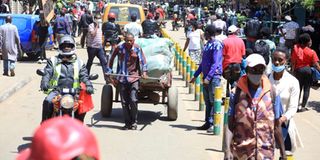Economy plunges into recession as Covid hits hard

Members of the public go about their businesses on Luthuli Avenue, Nairobi on January 5, 2020. The economy has slid into a recession for the first time in nearly two decades on the backdrop of a hard-hitting Covid-19 pandemic, signalling tough times ahead for Kenyan workers.
What you need to know:
- Before the decline in quarter two of 2020, the economy last contracted in the third quarter of 2008.
- The economy had expanded at a rate of 5.8 percent in the comparative third quarter of 2019.
The economy is officially in recession, the latest data has revealed, reflecting the pain unleashed by the global Covid-19 pandemic that triggered a near complete shutdown for most of last year.
Fresh economic data released by the Kenya National Bureau of Statistics (KNBS) yesterday shows that the country has a long way to go before it can start firing at pre-Covid-19 levels, even as the slowing rate of infections offer hopes for a quicker recovery this year.
The KNBS data shows that the economy contracted by 1.1 percent between July and September last year, making it the second consecutive quarter of Gross Domestic Product (GDP) shrinkage.
An economy is said to be in recession when its GDP growth rate is negative for two or more consecutive quarters.
The GDP recorded a negative growth of 5.7 percent in the second quarter between April and June 2020, as the Covid-19 induced shutdowns wreaked havoc on small businesses forcing closures and massive job layoffs.
Before the decline in quarter two of 2020, the economy last contracted in the third quarter of 2008, when post-election violence led to a 1.6% drop in output, according to the statistics office. The agency only started publishing quarterly GDP data in 2000.
“We have now entered 2021 with minimum buffers by private sector actors, households and even government having eroded part of the shielding in 2020,” said the CBK Governor Patrick Njoroge in a Monetary Policy Committee briefing released on Thursday.
“This makes building back tougher and more risky as we have to be more efficient in the use of resources.”
The economy had expanded at a rate of 5.8 percent in the comparative third quarter of 2019, illustrating the steep drop caused by the deadly virus.
Negative growth
KNBS attributed the negative growth to contraction in manufacturing and distributive trade sectors, which were hard hit by the shutdowns. This was worsened by significant under-performance in accommodation and food service sectors as well as the education sector that remains closed since mid-March last year.
KNBS said the slowdown in economic activity was evidenced by a 27.6 per ent drop in the NSE-20 Share index in the quarter under review, to stand at 1,852 points as at end of September 2020.
In the money market, the Kenyan Shilling depreciated against all major international trading currencies in the third quarter of 2020 compared to the corresponding quarter of 2019.
On average, the shilling depreciated by 9.8, 9.3, 5.6 and 2.8 per cent, respectively, against the Euro, Pound Sterling, Japanese Yen and US Dollar.
It, however, appreciated against regional currencies notably the South Africa Rand by 8.69 per cent in the quarter under review. The current account deficit improved by 10.6 percent from Sh157.9 billion in the third quarter of 2019 to Sh141.1 billion in the review period.
During a recession, businesses see sharp drops in demand for their goods and services. To cut costs and stem losses, companies begin laying off workers, generating higher levels of unemployment.
Kenya will need to expand by double digits in the remaining part of the year to jump into positive growth territory, which will be a tall order given that the economy has not grown by more than 10 percent in any year in the past decade.
KNBS said economic performance in the third quarter of 2020 remained depressed but relatively better compared to the second quarter of 2020.
It said the performance, albeit constrained, was supported by a significant improvement in agricultural production and accelerated growth in mining and quarrying, construction, and public administration.
Increasing joblessness
The performance is reflected in the shrinking tax collections, increasing joblessness, and struggling companies.
The Central Bank of Kenya (CBK) on Wednesday said that commercial banks have now restructured loans amounting to Sh1.63 trillion, which is more than half of all loans in the country, due to the Covid-19 pandemic. This is after borrowers took advantage of the relief announced by the CBK.
The CBK said that the Sh1.63 trillion restructured is equivalent to 54.2 percent of the total banking sector loan book of Sh3 trillion by the end of December.
CBK Governor Dr Patrick Njoroge said that out of this, personal and household loans amounting to Sh333 billion (39.6 percent of the gross loans to this sector) have had their repayment period extended.
For other sectors, a total of Sh1.29 trillion had been restructured mainly to trade (21.3 percent), manufacturing (20.4 percent), real estate (15.4 percent) and agriculture (12.4 percent).
The CBK said of the Sh35.2 billion that was released by the lowering of the Cash Reserve Ratio (CRR) in March, Sh32.6 billion (92.7 percent) has been used to support lending, especially to the tourism, trade and transport and communication, real estate, manufacturing and agriculture sectors.
The Monetary Policy Committee (MPC) on Thursday retained the CBK base lending rate at 7 percent, which means that banks will retain the rates they are charging borrowers at the current levels.
The MPC, which sets the rates banks use as a basis to price their loans, noted that the package of policy measures implemented since March 2020 were having the intended effect on the economy, and are being augmented by implementation of the announced fiscal measures in the 2020/21 budget.





